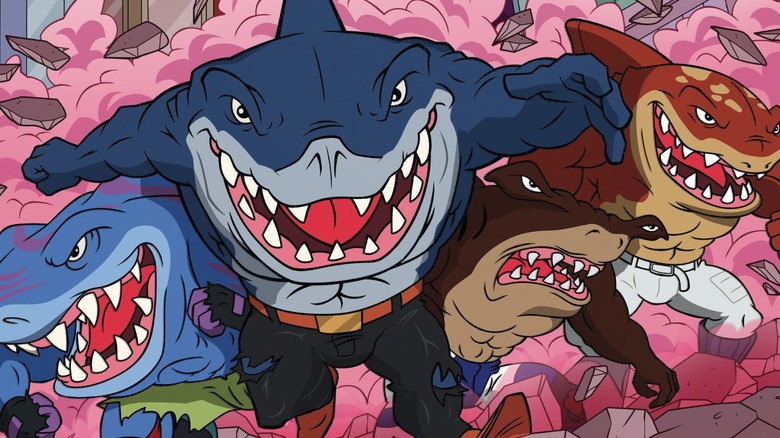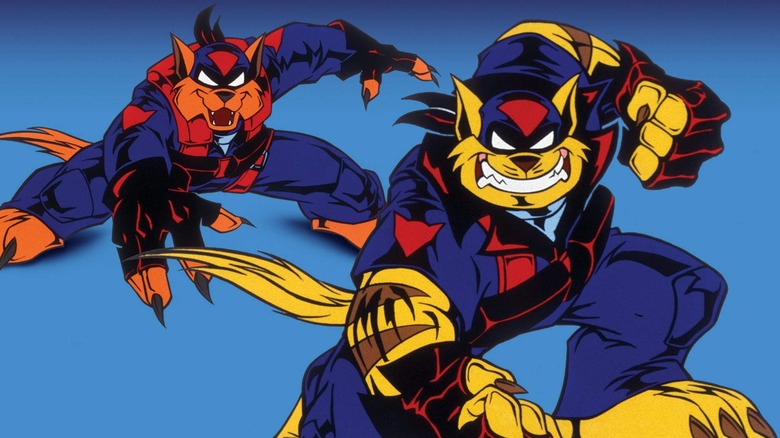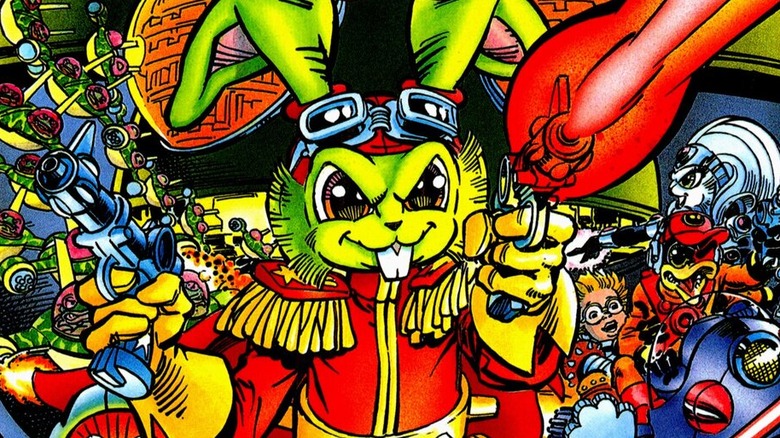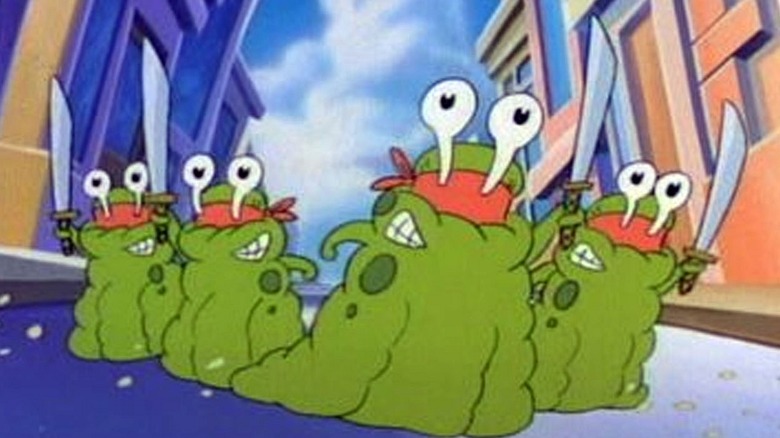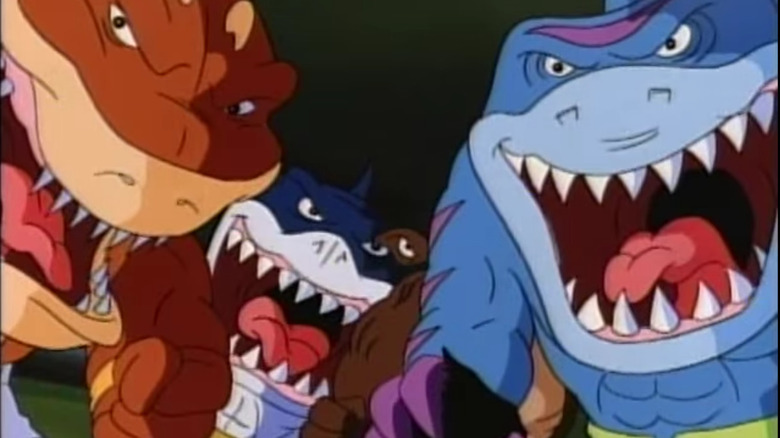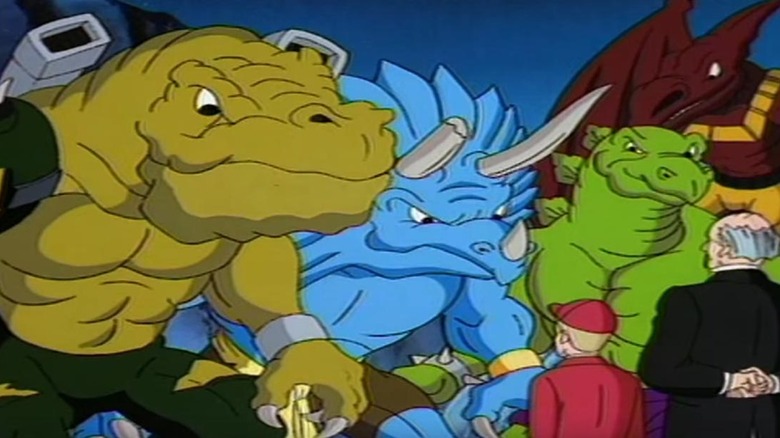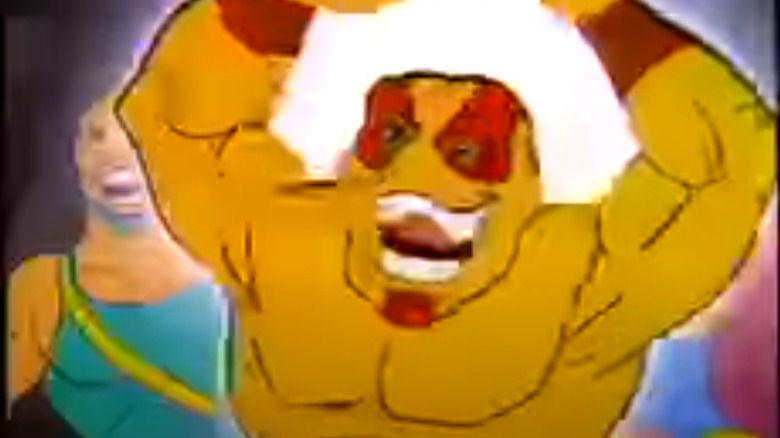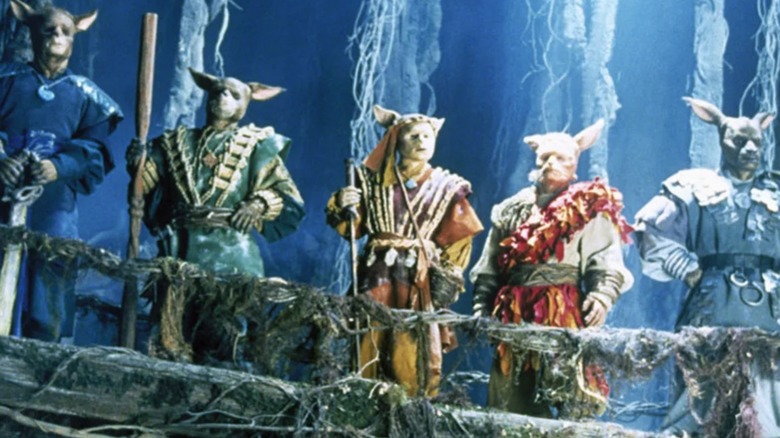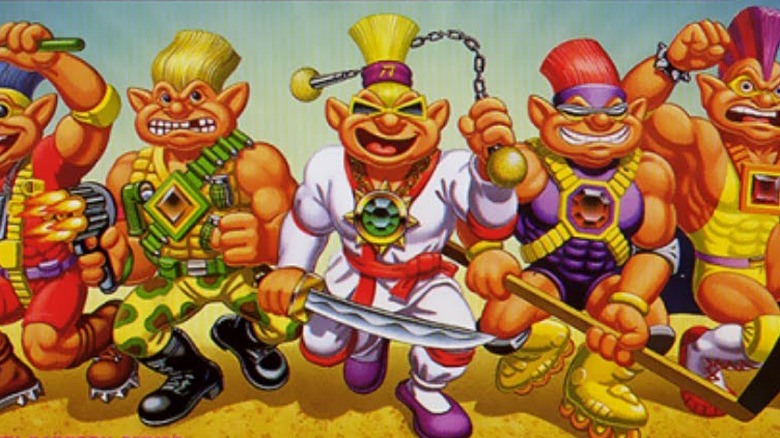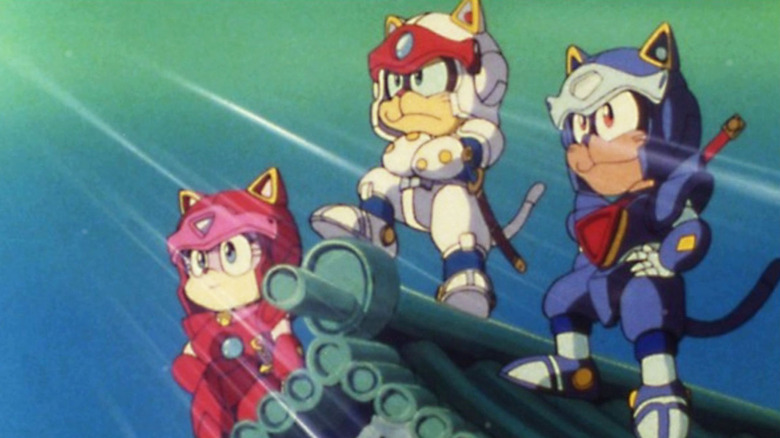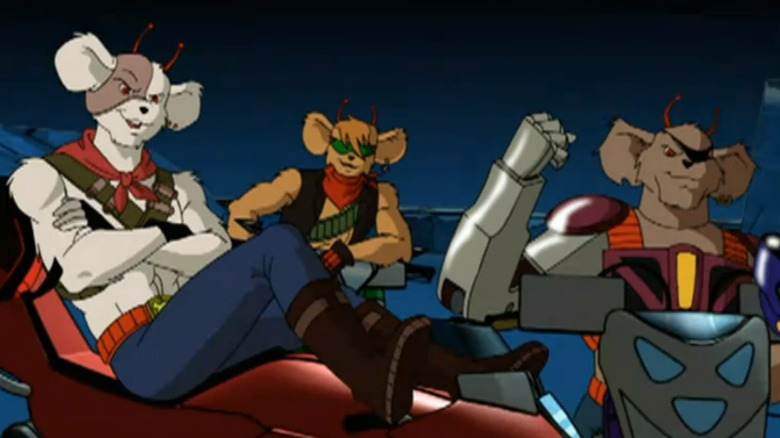'90s Teenage Mutant Ninja Turtles Rip Offs You Didn't Know About
The Teenage Mutant Ninja Turtles (TMNTs) used to be colossal.
Created by Kevin Eastman and Peter Laird as a riff on grimdark martial arts superhero comics, TMNTs went positively nuclear upon their repackaging as a goofy, kid-friendly animated series in the late 1980s. For some of us, the situation got weird. TMNTs action figures and accessories monopolized Christmas lists; birthday parties became pizza parties in order to better convey a TMNTs-oriented theme; if parents didn't buy TMNT breakfast cereal, shrill meltdowns would ensue.
Those days are long gone, but the TMNTs persist. A third theatrical iteration of the four reptilian siblings is slated for 2023, and their comics remain amongst the most popular not published by Marvel or DC. Even the classic TMNTs arcade scroller has undergone a fresh upgrade slated for 2022 dispersal.
Perhaps the conclusion of Leo, Don, Raph, and Mikey's imperial phase was a good thing for TMNT fans? Corporate America's maniacal scramble to squeeze every possible penny out of the turtles allowed for some questionable decisions, possibly inflicting long-term damage on the franchise's integrity. It also led to the production of opportunistic copycats designed to siphon some of that fat anthropomorphic fighting animal cartoon cash.
Here — in their varying degrees of respectability — are some of those copycats.
SWAT Kats: The Radical Squadron
Sure, the SWAT Kats are feline mammals who pilot customized, crime-fighting fighter jets; they're not reptiles, hand-to-hand combat isn't their primary specialization, and the two seasons of "SWAT Kats: The Radical Squadron" that aired from 1993 to 1995 might have more in common with "Batman: The Animated Series" than the cornball antics of 1987's "Teenage Mutant Ninja Turtles" show.
All that said, if you to picture Razor and T-Bone with their ears pulled back and their faces painted green, do you notice an uncanny resemblance? If you listen closely when Razor's speaking, you might notice that his voice actor, Barry Gordon, also provided the vocal cords for the '87 version of Donatello.
While there's an observable influence, "SWAT Kats" deserves recognition as more than just a TMNT rip off. If you disagree, you might have to take it up with "The Macho Man" Randy Savage.
Perhaps more pertinently, an attempt by the creators to produce a relaunch series dubbed "SWAT Kats: Revolution" almost tripled its recent Kickstarter goal. So, while Turner Broadcasting may have done a half-hearted job marketing "SWAT Kats" back in the day due to (valid?) concerns about its violence and mayhem, the series maintains an enthusiastic following. If the TMNTs weren't fictional, perhaps they wouldn't mind being a partial inspiration for the SWAT Kats.
Bucky O'Hare and the Toad Wars!
Technically, the comic book version of Bucky O'Hare — created in the late '70s by prominent Marvel scribe (and GI Joe mastermind) Larry Hama — made his grand premiere in 1984, the same year Eastman and Laird self-financed the first TMNT sequential art magazines. So while nobody can credibly accuse "Bucky O'Hare and the Toad Wars!" of starting out as a Turtles clone, let's face it; an obscure animal-themed sci-fi indie comic from the mid-'80s doesn't resurface in 1991 as a syndicated animated series unless TMNT rakes in an ocean of money a few years earlier. Even if "Bucky" doesn't steal from TMNTs, it absolutely plunders "Star Wars."
A show about a ragtag crew defying an intergalactic colonialist empire, "Bucky" essentially prepared millennial geeks to watch "Firefly" a decade later. Both programs have essentially the same premise, owe a massive debt to George Lucas, and lasted only one season.
Apparently boxes of "Bucky" action figures shipped out with insufficient numbers of heroic characters like Bucky, Deadeye Duck, and Willy DuWitt, but many more imperial toad flunkies than consumers were interested in purchasing. This led to less-than-adequate returns on the toy line and thus, the instant cancellation of the TV show.
Adults with vague memories of a green rabbit with an intense, practically xenophobic hatred of toads might be interested in Bucky's surprising connections to late '70s and '80s Marvel and DC Comics. Believe it or not, the final "Bucky" episode was written by Batman's own Neal Adams.
Immature Radioactive Samurai Slugs
As popular as TMNTs were in the late '80s and early '90s, many large groups of people hated them with a boundless, corrosive intensity. For instance, plenty of parents resented the TMNTs for their unrelenting, crass, and arguably exploitative product tie-ins; violent approach to conflict resolution; terrible dietary habits; and other attributes that made them less-than-stellar role models for the small children to whom they were aggressively marketed.
But there was one other group that hated the TMNTs even more than concerned parents: people who worked on competing cartoon shows.
While one connected to "Tiny Toon Adventures" has ever voiced public hatred of the TMNTs, it's hard to not detect some genuine malice in "Immature Radioactive Samurai Slugs" (IRSS) — the ersatz Turtles that Plucky Duck obsesses over in the 1990 episode "Mr. Popular's Rules of Cool."
In their theme song, the Slugs describe themselves as "cowabunga homeboys," and let's remember, absolutely no one outside of a niche surfer subculture had ever heard the phrase "cowabunga" until it became a TMNT catchphrase. Like the Turtles, the Slugs are named after artists — Warhol, Grandma Moses, Rockwell, and Picasso. This seems to be neither a subtle nor reverent homage.
Then again, "Tiny Toons" writer Gordon Bressack also penned a few episodes of "TMNTs," so perhaps the IRSS are not the hostile statement they appear to be.
Street Sharks
Before discussing "Street Sharks," it is worth noting for fans of "The Book of Mormon" and HBO's "Girls" that singer/comic actor Andrew Rannells played a talking, muscular shark-man on the show. So it's worth remembering, if only for that reason.
Obviously, just about every series mentioned here was designed to sell action figures, but according to SyFy Wire, the creator of "Street Sharks" — a toy designer, not a comics or television professional — called around to libraries to find out what kind of books were most popular with boys. Upon learning the answer to his query was books about sharks, he designed a new superhero toy line accordingly. Not only did Street Sharks action figures blow up in their day, the demand still persisted a quarter century after Streex, Big Slammu, Ripster, and Bends exited the airwaves in 1996 after three seasons.
In fact, "Street Sharks" might have a leg up on all the competition mentioned here in terms of Hollywood street cred. If the franchise can ever get a summer blockbuster greenlit, there's one A-list superstar who would undoubtedly sign on to play the lead.
Street Sharks owe plenty to TMNTs — they're crime-fighting humanoid creatures, there are four of them, they all talk like Poochie the dog — but as anyone who pays attention to the opening theme song sequence already knows, "Street Sharks" borrows just as much from a different classic cartoon; after all, Streex wasn't the first drum-playing shark.
Extreme Dinosaurs
Anecdotal evidence indicates that if there's one thing children love more than sharks, it's dinosaurs. So if Mattel based "Street Sharks" around the notion of marketing superhero shark action figures, superhero dinosaur action figures were the logical next step.
First appearing under the temporary sobriquet "Dino Vengers" during a time-travel crossover in the final season of "Street Sharks," the crew from "Extreme Dinosaurs" starred in a single 52-episode series that landed in 1997. Probably a few years too late to truly surf the aftershocks of TMNTs' merchandizing bonanza, "Extreme Dinosaurs" entailed evolved-up dinosaurs that have essentially the same group paradigm as the Turtles: they've got a leader, a hothead, a comedy guy, and a brainy guy, all via some unfathomable coincidence.
Weirder still, Spike the Triceratops and T-Bone the Tyrannosaurus carry laser guns. Sure, action figures need accessories, but it seems like humanoid dinosaurs would have no use for firearms. They could simply bite their enemies to death, or possibly gore them with their massive horns. If images like folks getting ripped in half or impaled are too potentially traumatic for the intended audience of "Extreme Dinosaurs," well, maybe that's another reason why way more people remember "Street Sharks" instead.
Snailiens — Supersonic Shell Fighters
The more honorable Ninja Turtle reproductions express a degree of obligation to offer consumers something beyond a faded Xerox. "Snailiens" does not belong amongst their ranks.
Washington, Jefferson, Lincoln, and Roosevelt are extraterrestrial gastropods in bulky, colorful suits of armor — shells, in a sense — throwing hands with nefarious Lunar-Ticks, who are also from outer space.
While a decayed TV advertisement on YouTube includes animation that implies the existence of a series (even going so far as to depict Washington spouting the insanely-original, obviously well-considered catchphrase, "Let's Kick Some Tick!"), no such program ever manifested itself. Nor is there a "Snailiens: Supersonic Shell Fighters" comic book or video game; the JPI toy company cut right to the chase and dashed the action figures into stores in 1992.
While it's hard to definitively conclude whether Snailiens moved enough product to become anything close to a success, it seems likely that even kids in early '90s rolled their eyes at this unimaginative, blatant cash grab.
Warriors of Virtue
There simply isn't enough space to cover every cartoon and toy franchise that has borrowed from the Teenage Mutant Ninja Turtles — there's a good reason for that, and it's because wannabe TMNT franchises throughout the '90s turned a profit. That's what made "Warriors of Virtue" (1997) a special case. Whereas "Street Sharks," "Biker Mice From Mars" and "Battletoads" became demonstrable money makers, "Warriors" was a creative and financial catastrophe.
While an oft-circulated story about a critic puking during a test screening may or may not be true, critics definitely did not enjoy this 1997 film, and moviegoing audiences barely realized it existed. Ultimately, the theatrical run of "Warriors" took in less than $7 million.
Directed by Ronny Yu before he made it in America with horror gems "Bride of Chucky" (1998) and "Freddy vs. Jason" (2003), "Warriors of Virtue" drops a dumb suburbanite kid (Mario Yedidia) into a magical land defended by kangaroo martial arts masters from a psychotic royal despot. To call it a Ninja Turtles rip off is almost too generous: The trailer alone features themes and dialogue lifted from Power Rangers, Captain Planet, and even "The Warriors" (1979).
Doug Jones — future Amphibian Man from "The Shape of Water" (2017) — played one of the Kangaroos. So the moral of this story is, don't give up on your dreams.
Stone Protectors
Almost all TMNT knockoffs are, by definition, less ridiculous than the TMNTs. The students of Splinter set all the precedents, which makes the franchises that arrive later look mundane by comparison. If an anthropomorphic turtle were to kick down your door and yell "Cowabunga!", that would make for a very entertaining encounter; if an anthropomorphic shark kicked down your door 10 minutes later shouting "Jawesome!", that would feel a bit derivative.
But the "Stone Protectors" — while clearly lifting the Ninja Turtles' surfer dude buzzword-spouting personalities — were not only an exception, but a whole new level of insane. They were Trolls — as in, part of the same franchise that would later include "Trolls World Tour" (2020) — but they were also a rock 'n roll band that battled evil in their spare time; eat your heart out, Buckaroo Banzai.
Each individual stone protector incorporated a theme. The leader was a martial arts master (because, of course the team had a martial arts master), one of them was a professional wrestler and there was another stone protector who was a hockey player, for some reason.
Anyway, the Stone Protectors franchise includes a toy line, a board game, a video game, and an animated series that, despite meeting cancellation before the end of Season 1, is evidently remembered fondly by some folks on the "Robot Chicken" writing staff. Stone Protectors remains viable enough that just under 400 people backed a 2021 Kickstarter relaunch, so let's give them credit for establishing a legacy, in spite of their utter madness.
Samurai Pizza Cats
First broadcast in the early '90s under the title "Kyatto Ninden Teyandee" (Cat Ninja Legend Teyandee), the program that became "Samurai Pizza Cats" (SPC) underwent a complete overhaul of its original dialogue upon its refashioning for American audiences under the proprietorship of Saban Entertainment.
There's a bunch of possible reasons why. Toy Galaxy, in their extensive SPCs retrospective, theorizes the "Kyatto Ninden Teyandee" scripts may have included too many jokes that reference Japanese culture with too much specificity for a typical American audience to understand. This much is clear: The American "SPC" references turtles right up front in the intro music.
This show's journey from a highly-satirical Japanese cartoon laced with winking meta-humor to an American cult hit buried under licensing issues and (probably warranted) censorship was a wild one, and definitely gave SPC a notoriety beyond its similarities to TMNT. There are also plenty of superficial differences: The Pizza Kats are technically part-robot, part-cat; they defend the fantastical city of Little Tokyo which doesn't resemble a real city in the slightest; "SPC" was also the rare TMNT-ripoff with an honest-to-gosh girl on the team.
Biker Mice from Mars
Possibly the most famous of all the TMNTs rip offs — Biker Mice From Mars (BMFM) — was inspired during an encounter between creator Rick Ungar and a biker gang, according to a 1994 profile in the LA Times. Though menacing from a distance, upon closer inspection, the bikers turned out to be harmless yuppies, and the experience made Ungar realize that motorcycles are cool.
BMFM isn't the best-known second-string TMNT simply because of the similar-sounding title — it's also probably the most prolific, smashing out 65 episodes from 1993 to 1995, plus a 27-episode revival season in the mid-'00s. Ungar fulfilled managerial roles on numerous Marvel animated projects throughout the '90s; it's not a coincidence that "BMFMs" is one of the few projects that counts Stan Lee as an executive producer despite not starting out as a Marvel comic.
It also helps that Rob Paulsen voiced Throttle (the unofficial leader of the Biker Mice) as well as Raphael in the 1987's "TMNTs" and Donatello in the CG revival from 2012. So, not only are the Biker Mice giant humanoid animals who fight crime, one of them is literally two Ninja Turtles. Ian Ziering went on to be better known as the dude from the "Sharknado" series following his role as Vinnie — and if the BMFM ever want to escape the shadow of the Ninja Turtles, a "Sharknado" crossover might just do the trick.
